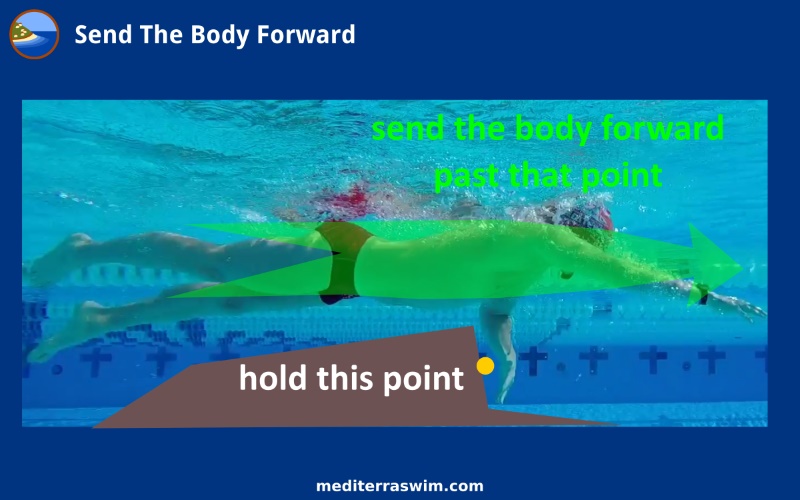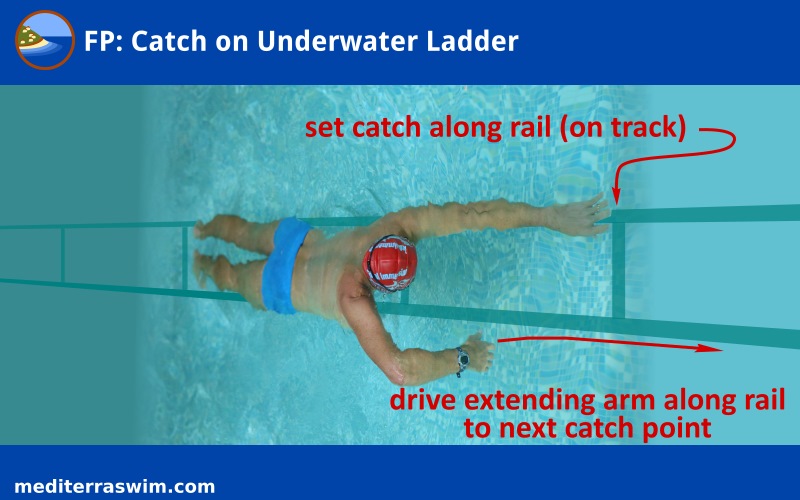Forums › Library › Swim Course Instructions › Catch Introduction
Please type your comments directly in the reply box - DO NOT copy/paste text from somewhere else into the reply boxes - this will also copy the code behind your copied text and publish that with your reply, making it impossible to read. Our apology for the inconvenience, but we don't see a convenient way of fixing this yet.
Tagged: catch, propulsion, synchronization
-
AuthorPosts
-
January 2, 2018 at 07:59 #16668
Admin Mediterra
KeymasterThe underwater catch/hold phase of the stroke is known as the ‘underwater pull/push phase’ in the conventional swimming world. We call it the ‘catch’ and ‘hold’ because our orientation is about holding a point in the water and sliding the body forward, past that point. Our emphasis is on the body moving forward, not on pushing water backward.

Think of this analogy: when you are walking or running, the foot that is staying in contact with the ground is providing traction so that you can move the body forward, past that foot. If you were walking on a slope with sand or lose gravel, and if you were to emphasize the push-back of that foot on the ground, your foot would move backward more than your body would move forward. Instead, your brain knows it needs to press on that loose ground carefully, in such a way that you are able to move the body forward more than the foot slips backwards. This is a very similar situation to your stroke in the water, because water molecules that you are trying to get traction with are even more loose than gravel on a slope!
Below is an outline for how we form the catch, and you will find some additional focal points and diagrams on the 101 Focal Points page under the Catch section.
The catch has a certain timing, a particular shape, an intentional pathway and a certain amount of pressure to make it most effective. The better the catch the more force that side of your body is able to generate and make available. The better the timing with your torso rotation, the more that force is delivered to the other Forward-Moving side of the body. The better your Entry and Skate Position, the more that force is transferred into forward motion.
Let us reiterate this again so that it sinks in: The whole emphasis of the stroke is to Send Force Forward, or in other words, to send the vessel of your body forward. It is tempting to the land-mammal brain to emphasize the pull on the water, but this is not the primary action of the stroke, the catch is only a supportive, secondary action.
Instructions
There are a couple images we like to use to work on the shape and pathway:
- the ‘beach ball’ of water molecules (or ‘pilates ball’ if you prefer)
- swimming along the ladder under your body, parallel to the surface

The ‘beach ball’ of water molecules represents the pressure zone of water you create and direct with each underwater stroke. You form this pressure zone then send it under your body, especially under your hips and legs to help those ride higher in the water. This ball of pressure is shallow, close to your body, not down deep. You form this pressure zone of water with each catch, and then slide the body over this pressure zone on each stroke. Imagine sliding your body over the beach ball on each stroke.

The ‘underwater ladder’ gives you a directional grid to set the placement and trajectory of your movements. The two rails correspond to your two arm tracks, and your arms extend forward on that rail, and your catch holds that point on the rail; the rungs represent the point ahead where you set your catch (get a grip on the water); the depth of the imaginary latter determines the depth of your catch, where that pressure zone is created so that your body-frame can slide over it.
Useful Drills For Catch
- Standing rehearsal with catch shape
- 1-Arm Drill (other arm tucked at the side)
- Skate Plus 1-Arm Drill (lead arm in front, other arm doing the catch)
- Swing Switch (two arms) with pause at Entry moment
- Fist Swimming in Whole Stroke
- Whole Stroke
The 1-Arm drill is particularly effective at showing you how the catch must be connected to the torso rotation. With only one arm to work with, it feels difficult and awkward to pull against the water without using the torso to do it. So it is virtually necessary to connect the torso rotation to a 1-Arm stroke to make it possible to do more than a few strokes. Feel how those two parts are meant to work together and memorize that connection. Then add the other arm back into the choreography, while preserving that timing of the catch and torso rotation.
Shape Focal Points For Catch
- Touch The Ball (set the catch)
- Hand stays on track
- Elbow slide out and upward to make shape of arm
- Touch the ball with entire forearm and palm
- Keep ‘arm wrestle’ bend at the elbow as you pull through
- Press with the entire forearm
Pathway Focal Points
- Hand sets the catch, on track with the shoulder
- Press the ball straight toward the hip – hips rolls out of the way at last moment
- Press the ball straight toward the toes – send the ball of water close to the body, under hip and leg
- The catch hand and the extending lead arm move on their tracks in the exact opposite direction from each other
Timing Focal Points
- Hold the ball and use rotation to slide the body past it
- Hesitate ever so slightly after ‘Set The Catch’ in order to Load The Torso (load the back muscles)
- Pull with hip (not with shoulder) – as if an elastic band connects hip to wrist
Pressure Focal Points
- Start soft and gradually increase pressure on the ball
- Press on the ball steadily all the way through the motion
- Don’t ‘pop the ball’ – press smoothly, do not pull abruptly
- Catch hand and extending lead hand move opposite to each other, at approximately the same rate of speed
Remember: the entry and extending arm is the main actor, while the catch arm is the supporting actor. Set a good catch and then focus upon sending force forward into your best Skate Position. The better your Entry, Extension and Skate, the farther you will slide forward on each stroke!
-
AuthorPosts
- You must be logged in to reply to this topic.
